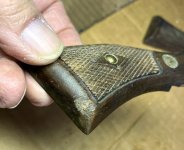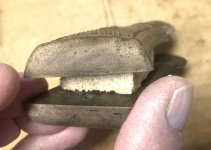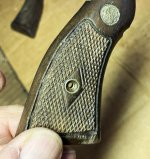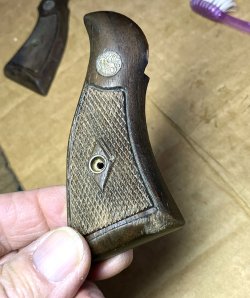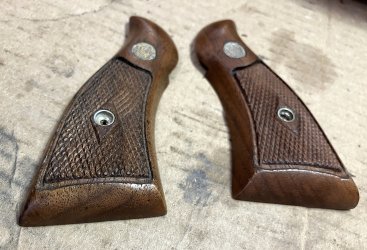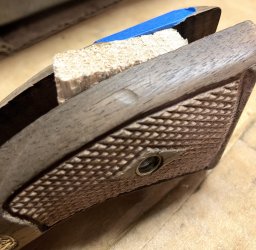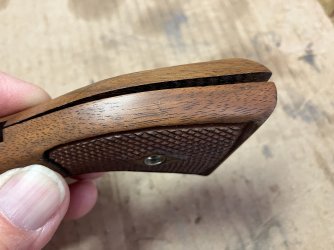Do you have a piece or pieces missing from the ear of that panel? I think I see that in the pics.
Sometimes I glue in a piece of wood and file and sand to shape.
A shallow chip like this can often be done with a very thin wood repair piece that is pressed hard into the damage and glued in place.
I like super glue for this as it dries quickly, a few seconds to a minute.
It'll look crude when you you release the pressure however applied (tip of a screwdriver, old file surface, hammer face,,ect)
But now you can use the over hanging wood from the repair chip as filler for the remaining missing wood.
To do this, first clip any real long pieces of repair chip off.
Then place super glue onto the surface of the damage around the repair.
Then quickly sand the extra wood down to create a dust that will be packed into the remaining voids with that glue.
Use a coarse sand paper like 150grit or 180.
The glue and dust will set up FAST,,a few seconds and load the sand paper as well.
You will probably have a few voids to fill.
More glue and sand again. Quickly and aggressivly to create wood dust, that's why you use the coarse grit paper.
Use a garnet or even a flint paper. Anything other than one of the colored sand papers which will dump that color into the repair and glue.
If you have some voids that you can pack a wood chip into, do that instead of letting the glue & dust mixture fill the entire void. Then glue and ssand over those chips. They can add some grain and more varied color to the repair.
It only matters visually what's on the surface of the repair.
Keep going, using a new area on the sand paper of course as each time it will be loaded with dried glue and wood dust.
When done it should be a slightly higher mound of hardened wood, wood chip(s) and glue.
Now with med and fine cut files, shape it down to where it needs to be. The sand the surface to finish it up smooth. Back the sanding process with a hard surface, I always wrap the sandpaper around a file. But most any flat wooden or metal piece will do.
Sometimes on curved surfaces a rubber erasure works well to conform to those areas and not leave shatter marks.
The completed repair will likely be somewhat darker than the bare wood around it.But carefull staining and some faux graining with stains and acrylic or even oil based artists paints can make the repair disappear.
Then 'fix' your art work with a spray coating of a clear poly or laq.
I sometimes use thinned shellac applied with a tiny wad of paper towel very carefull. Just enough to protect the staining and coloring from the final finish being applied. Apply this quickly and in one stroke. Don't go back and forth over it if you use a brush or tuft of cloth to apply.

